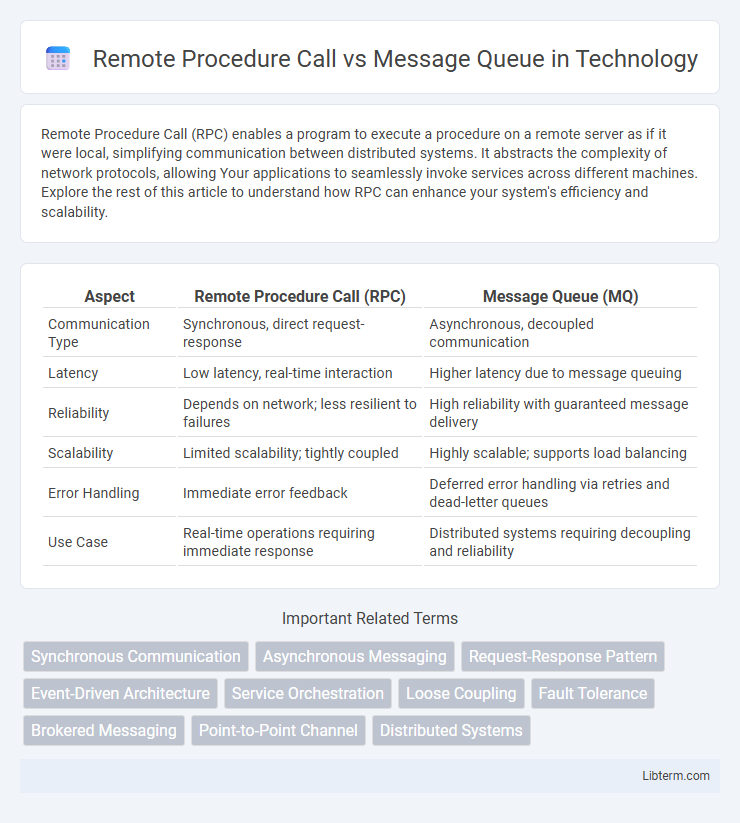Remote Procedure Call (RPC) enables a program to execute a procedure on a remote server as if it were local, simplifying communication between distributed systems. It abstracts the complexity of network protocols, allowing Your applications to seamlessly invoke services across different machines. Explore the rest of this article to understand how RPC can enhance your system's efficiency and scalability.
Table of Comparison
| Aspect | Remote Procedure Call (RPC) | Message Queue (MQ) |
|---|---|---|
| Communication Type | Synchronous, direct request-response | Asynchronous, decoupled communication |
| Latency | Low latency, real-time interaction | Higher latency due to message queuing |
| Reliability | Depends on network; less resilient to failures | High reliability with guaranteed message delivery |
| Scalability | Limited scalability; tightly coupled | Highly scalable; supports load balancing |
| Error Handling | Immediate error feedback | Deferred error handling via retries and dead-letter queues |
| Use Case | Real-time operations requiring immediate response | Distributed systems requiring decoupling and reliability |
Introduction to Remote Procedure Call (RPC) and Message Queue (MQ)
Remote Procedure Call (RPC) enables a program to execute a procedure on a remote server as if it were local, facilitating direct communication between client and server through synchronous requests and responses. Message Queue (MQ) introduces asynchronous communication by allowing applications to exchange messages via a queue system, decoupling sender and receiver and improving scalability and resilience. Both RPC and MQ play critical roles in distributed systems, with RPC emphasizing real-time interaction and MQ prioritizing reliable and decoupled message delivery.
Core Concepts: RPC and MQ Explained
Remote Procedure Call (RPC) enables direct execution of a procedure or function on a remote server, facilitating synchronous communication with immediate responses. Message Queue (MQ) systems manage asynchronous message exchanges between distributed components, decoupling producers and consumers to improve scalability and reliability. While RPC depends on real-time availability and tight coupling, MQ ensures message persistence, fault tolerance, and eventual consistency across distributed systems.
Communication Patterns: Synchronous vs Asynchronous
Remote Procedure Call (RPC) employs a synchronous communication pattern where the client waits for the server to process the request and return a response, ensuring immediate interaction. Message Queues utilize asynchronous communication, decoupling the sender and receiver by allowing messages to be stored and processed independently, improving system scalability and fault tolerance. Synchronous RPC is ideal for real-time operations requiring instant feedback, while asynchronous Message Queues support high-throughput and resilient workflows in distributed systems.
Performance and Scalability Considerations
Remote Procedure Call (RPC) offers low-latency communication ideal for real-time, synchronous interactions but can suffer from scalability issues due to tight coupling and blocking calls. Message Queues facilitate asynchronous, decoupled processing that enhances scalability by enabling distributed, load-balanced workloads and improving fault tolerance. Performance in RPC is typically faster for direct calls, whereas Message Queues excel in handling high throughput and resilient, scalable architectures.
Reliability and Fault Tolerance
Remote Procedure Call (RPC) offers synchronous communication, providing reliability through immediate response but can suffer from poor fault tolerance due to tight coupling and failure dependencies between client and server. Message Queues enhance fault tolerance by enabling asynchronous communication, persisting messages to ensure delivery even during system outages, which increases overall reliability in distributed systems. The decoupled architecture of message queues allows independent processing and retry mechanisms, reducing the risk of system-wide failures compared to RPC.
Use Cases: When to Use RPC or MQ
Remote Procedure Call (RPC) excels in scenarios requiring synchronous communication and immediate response, such as microservices invoking operations that depend on real-time data or direct client-server interactions. Message Queue (MQ) is ideal for asynchronous, decoupled workflows where tasks can be processed independently, like order processing systems, event-driven architectures, or distributed systems needing reliable message delivery and load balancing. Choosing between RPC and MQ depends on the need for real-time communication versus durable, scalable message handling in distributed applications.
System Coupling and Flexibility
Remote Procedure Call (RPC) creates tight system coupling by requiring direct, synchronous communication between client and server, which limits flexibility in handling network latency or partial failures. Message Queues promote loose coupling by enabling asynchronous, decoupled communication where producers and consumers operate independently, enhancing system scalability and fault tolerance. This architectural difference makes Message Queues more suitable for distributed systems requiring high flexibility and resilience.
Error Handling and Recovery Mechanisms
Remote Procedure Call (RPC) implementations often rely on synchronous communication, which simplifies error detection through immediate response codes but can struggle with partial failures and timeout scenarios. Message Queues use asynchronous messaging that enhances error handling by enabling message persistence, retries, and dead-letter queues, ensuring reliable recovery even during system failures. Robust recovery mechanisms in message queues support eventual consistency, while RPC requires additional orchestration to manage rollback and retry logic.
Security Implications of RPC and MQ
Remote Procedure Call (RPC) security often faces risks such as interception, spoofing, and unauthorized access due to direct communication between client and server, necessitating strong encryption and authentication mechanisms like TLS and OAuth. Message Queues (MQ) enhance security by decoupling services and supporting secure message storage with features like encryption at rest, access control lists (ACLs), and message integrity checks, reducing attack surfaces. While RPC requires stringent endpoint protection, MQs provide asynchronous communication that inherently limits exposure to real-time attacks, making them preferable in sensitive distributed systems requiring robust security controls.
Future Trends and Emerging Technologies
Remote Procedure Call (RPC) is evolving with advancements in gRPC and WebAssembly, enabling more efficient, low-latency communication for microservices and edge computing. Message Queue systems are integrating AI-driven orchestration and serverless architectures to enhance scalability and fault tolerance in distributed environments. Future trends emphasize hybrid models combining RPC's synchronous calls with message queue's asynchronous processing, optimized by blockchain for secure and traceable transactions.
Remote Procedure Call Infographic

 libterm.com
libterm.com